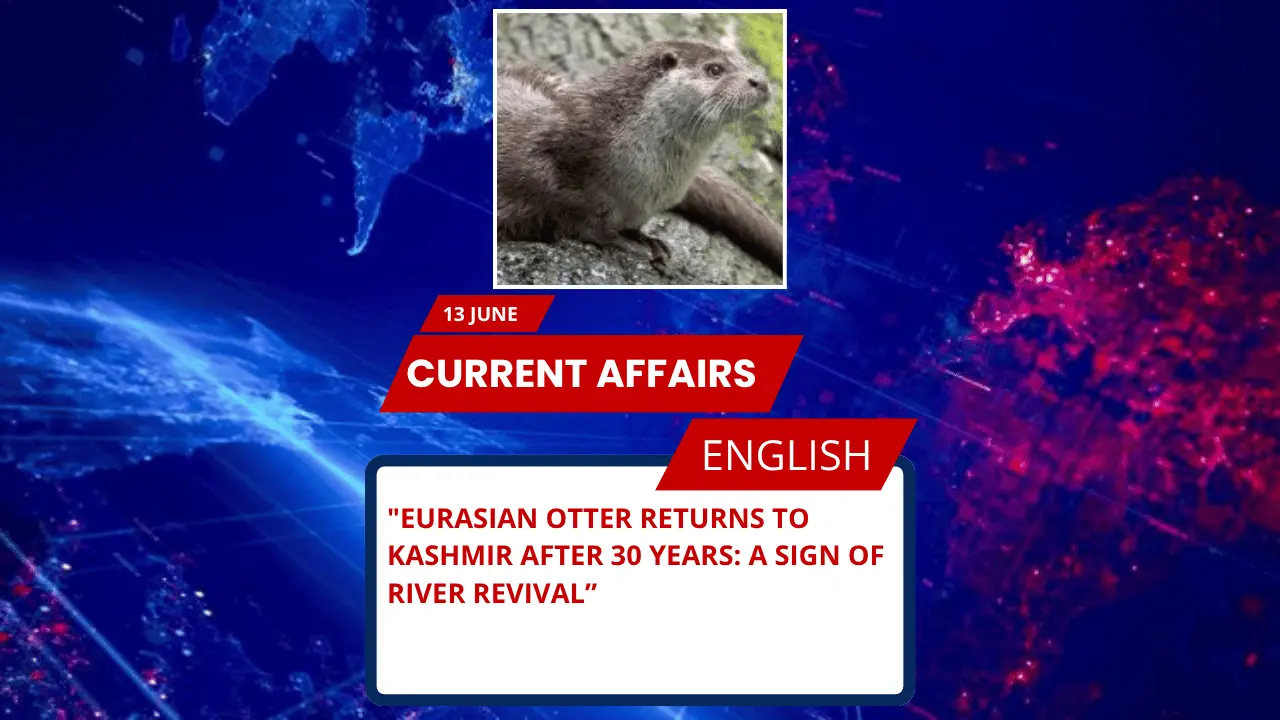
Key Points for SSC, UPSC & Other Government Exams
- Species Spotted: Eurasian Otter (Lutra lutra), locally known as Wuddar.
- Location: Tributary of Lidder River near Srigufwara, Bijbehara, South Kashmir.
- IUCN Status: Near Threatened.
- Importance: Indicator of clean water and healthy ecosystems; keystone species.
- Other Sightings: Chenab River, Rambiara stream (Shopian), Gurez Valley (Bandipora).
- Threats: Habitat loss, water pollution, poaching, wetland destruction.
- National Presence: Western Ghats, Himalayan foothills, Goa, North-East India, Chambal river stretch.
Detailed Explanation
Eurasian Otter Spotted in Kashmir: A Rare Conservation Success
In a landmark event for Indian wildlife, the Eurasian Otter (Lutra lutra) has been sighted in Kashmir after nearly three decades. The elusive mammal, considered a keystone species of river ecosystems, was spotted near Srigufwara in Bijbehara, a town in South Kashmir. This sighting signals not just the presence of the species but also hints at the possible ecological revival of Kashmir’s riverine habitats.
Ecological Importance of Eurasian Otter
The Eurasian Otter plays a vital role in maintaining freshwater ecosystem balance. Its presence is proof of:
- Minimal water pollution.
- Stable aquatic food chains (as it preys on fish and invertebrates).
- Healthy water flow in river systems.
The species’ return points towards improvement in river conditions which are crucial for agriculture, drinking water supply, and local livelihoods.
Other Sightings in Kashmir
This sighting is part of a pattern of otter reappearance across Jammu and Kashmir:
- Chenab River
- Rambiara Stream (Shopian)
- Gurez Valley (Bandipora)
These sightings across diverse terrains highlight the existence of pockets of healthy freshwater habitats.
Threats to Eurasian Otter
Despite this positive news, the species continues to face significant threats:
- Shrinking wetlands
- Water pollution
- Habitat fragmentation
- Poaching (especially for fur)
It remains listed as Near Threatened on the IUCN Red List.
Distribution of Eurasian Otter in India
Besides Kashmir, Eurasian Otters are found in:
- Western Ghats (Karnataka, Kerala)
- Himalayan foothills (Uttarakhand, Himachal Pradesh)
- Goa
- North-East India (Arunachal Pradesh)
- Chambal river stretch (Madhya Pradesh)
Important Facts About Jammu & Kashmir (for Exams)
- Capital: Srinagar (Summer), Jammu (Winter)
- Lieutenant Governor: Manoj Sinha (as of 2025)
- Major Rivers: Jhelum, Chenab, Lidder, Ravi, Tawi
- Famous National Parks: Dachigam National Park, Hemis National Park, Kishtwar National Park, Salim Ali National Park
MCQs (Exam Style)
1. The recent sighting of Eurasian Otter in Kashmir indicates:
A) Degradation of river ecosystem
B) Increase in water pollution
C) Revival of riverine health
D) Decline in aquatic biodiversity
Answer: C) Revival of riverine health
2. The Eurasian Otter is classified under which category by IUCN?
A) Endangered
B) Critically Endangered
C) Vulnerable
D) Near Threatened
Answer: D) Near Threatened
3. Which of the following rivers is associated with the latest otter sighting in Kashmir?
A) Chenab
B) Lidder tributary
C) Jhelum main channel
D) Tawi
Answer: B) Lidder tributary
4. Eurasian Otter is an indicator of:
A) High soil erosion
B) Clean water ecosystem
C) Dry river beds
D) Saline water conditions
Answer: B) Clean water ecosystem
UPSC-Style FAQs with Model Answers (Answer Writing Format)
Q1. Discuss the significance of Eurasian Otter as a keystone species in the context of freshwater ecosystems of Kashmir. (150 words)
Model Answer:
The Eurasian Otter (Lutra lutra) is considered a keystone species due to its crucial role in maintaining the ecological balance of freshwater ecosystems. In Kashmir, the recent sighting of this species after nearly 30 years marks a positive ecological signal. Otters regulate the population of fish and aquatic invertebrates, thus ensuring biodiversity and food web stability. Moreover, their presence reflects low chemical pollution and healthy water flow, vital for sustaining riverine habitats that support agriculture and drinking water for communities. As Kashmir’s rivers face threats from habitat fragmentation, pollution, and climate change, protecting the otter indirectly safeguards the overall health of these aquatic systems. The return of otters suggests a potential revival of river ecosystems and underlines the need for integrated conservation policies targeting habitat restoration, pollution control, and community awareness.
Q2. Examine the challenges and strategies for conservation of Eurasian Otters in India. (250 words)
Model Answer:
The conservation of Eurasian Otters in India faces multiple challenges. Chief among them is habitat destruction due to urbanization, sand mining, and unregulated tourism. Wetlands and riverine habitats are shrinking rapidly, directly impacting the otters’ prey base. Water pollution from industrial, agricultural, and domestic sources further degrades their environment. Additionally, otters are illegally hunted for their fur, posing a threat to their population.
To address these issues, multi-pronged strategies are essential. Firstly, habitat protection through the creation and strict management of protected areas along river stretches is necessary. Secondly, pollution control measures, including enforcement of environmental laws and promotion of eco-friendly agricultural practices, should be prioritized. Community participation in conservation efforts, through awareness campaigns and alternative livelihood options for local communities, can reduce poaching pressure. Moreover, scientific studies on otter population and habitat use are crucial for evidence-based policy formulation. Integrating otter conservation into river basin management plans would help balance ecological health with developmental needs.







